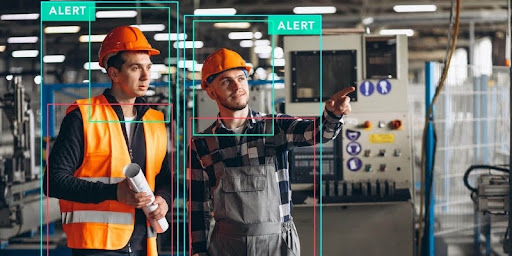
As factories race toward greater efficiency and agility, manufacturers who fail to embrace smart technologies risk falling behind. This shift is driven by the powerful convergence of AI and IoT that is called AIoT. In this post, we’ll explore AIoT applications in smart manufacturing to see how combined technologies redefine manufacturing.
The Role of AIoT in Manufacturing
AIoT, or Artificial Intelligence of Things, is the fusion of two transformative technologies – AI and IoT. In manufacturing, this powerful combination connects a network of smart sensors and machines with advanced algorithms that can analyze, learn, and act in real time. While IoT collects massive amounts of operational data, AI interprets it, enabling systems to make proactive, intelligent decisions without human prompting.
At its core, smart manufacturing automation enabled by AIoT turns factories from reactive environments into proactive ecosystems. Instead of responding to problems after they arise, AIoT empowers machines and systems to anticipate them – ensuring optimal performance, minimizing downtime, and helping manufacturers stay ahead in an increasingly competitive landscape.
Ultimate 7 AIoT Applications in Smart Manufacturing
When AI and IoT in Smart Factories combine, their synergy can do more than what any manufacturer can imagine. Let’s have a closer look at the various AIoT applications in smart manufacturing.
Quality control monitoring
AIoT is revolutionizing quality assurance by enabling real-time, automated inspection throughout the production process. With smart cameras, sensors, and machine learning integration, manufacturers can detect even the slightest defects that traditional systems or human eyes might miss.
Instead of relying solely on manual checks or rule-based systems, AI-powered vision solutions now analyze video feeds and sensor data to instantly flag anomalies or inconsistencies. This not only ensures consistent product quality but also reduces waste, lowers inspection costs, and speeds up fault detection and corrective action. As a result, quality control becomes smarter, faster, and more reliable, laying the foundation for truly intelligent manufacturing.
Predictive maintenance
Predictive maintenance is one of the most powerful AIoT applications in smart manufacturing. With AIoT in industrial automation, maintenance becomes smarter and more strategic. By continuously monitoring equipment through sensors that track data like temperature, vibration, and pressure, AIoT systems can detect subtle signs of wear and predict failures before they occur. AI algorithms analyze this real-time data to identify patterns that signal potential breakdowns, allowing manufacturers to schedule maintenance in advance.
Such a proactive approach to equipment and machinery maintenance minimizes unexpected downtime, reduces repair costs, and extends asset lifespan. From factory floors to complex pipelines, predictive maintenance powered by AIoT helps keep operations running smoothly and efficiently.
 AI for predictive maintenance
AI for predictive maintenance
Supply chain optimization
AIoT is revolutionizing supply chain operations by making them faster, smarter, and more responsive. With IoT sensor networks tracking goods in real time and AI algorithms analyzing vast data streams, manufacturers gain full visibility over their logistics, from warehouse shelves to delivery trucks. These intelligent systems don’t just react – they anticipate.
By forecasting demand patterns, adjusting inventory levels, and identifying supply bottlenecks before they escalate, AIoT empowers businesses to stay ahead of disruptions. In fleet management, for instance, real-time GPS data combined with AI-driven route optimization helps avoid delays and cut fuel costs. Meanwhile, smart warehouses automate procurement and manage storage space with impressive precision. The result? A leaner, more agile supply chain that meets customer needs with speed and accuracy.
Smart asset management
AIoT applications in smart manufacturing bring a new level of intelligence to asset management by offering real-time visibility into asset performance and health. With connected sensors feeding continuous data into AI-powered platforms, manufacturers can track how assets measure up against key performance indicators (KPIs) and instantly detect any deviations. Instead of waiting for issues to surface, smart CCTV systems send automated alerts when abnormal behavior is detected, allowing for swift, targeted responses.
This proactive approach not only prevents costly breakdowns but also ensures machines are running at peak efficiency. More importantly, the feedback loop from live performance data enables teams to refine KPIs over time, leading to faster production cycles, better resource utilization, and continuous process improvement.
 Smart asset management
Smart asset management
Energy consumption tracking and management
Energy efficiency is no longer just a cost-saving measure; it’s a key pillar of sustainable manufacturing. AIoT empowers factories to monitor and manage their energy usage with precision. By analyzing real-time data from connected devices, manufacturers can identify inefficiencies, track usage patterns, and detect anomalies like unexpected energy spikes or leaks. These insights enable informed decisions, such as switching to more energy-efficient alternatives or adjusting operations during peak consumption periods.
AI-driven analytics also help uncover how individual assets contribute to overall energy use, making it easier to target specific areas for improvement. Beyond optimizing costs, this capability significantly boosts environmental sustainability. With smart manufacturing automation enhanced by AIoT, companies can proactively reduce their carbon footprint and operate with greater ecological responsibility, turning energy management into both a business and environmental win.
-
Employee safety enhancement
Creating a safer work environment is a top priority for manufacturers – and thankfully, AIoT applications in smart manufacturing are making that happen. With advanced sensors monitoring for gas leaks, abnormal temperature changes, or other hazardous conditions, factories can instantly alert workers and supervisors before risks escalate. AIoT also supports automated emergency protocols, enabling swift responses when accidents occur.
On the frontline, wearable technologies like smartwatches, AR glasses, and sensor-embedded PPE (helmets, gloves, safety goggles) are transforming worker safety. These devices deliver real-time updates on machine status or production schedules and continuously monitor environmental exposure and equipment condition. This real-time feedback helps prevent injuries, improves adherence to safety protocols, and ultimately enhances operational awareness.
 AI for employee safety enhancement
AI for employee safety enhancement
AIoT-powered digital twin technology
Digital twins – virtual replicas of real-world assets, systems, or processes – have revolutionized how manufacturers approach design, operations, and maintenance. But when combined with the intelligence of AIoT, these twins become far more powerful, turning from passive models into active decision-makers.
AIoT applications in smart manufacturing enable digital twins to receive real-time data streams from connected sensors embedded in equipment and environments. This live feed enables up-to-the-second monitoring, making simulations more accurate and predictive insights more reliable. Instead of simply reflecting the current state of machinery, AIoT-powered twins can detect early warning signs of failure and trigger maintenance automatically, helping prevent costly downtime.
Moreover, by applying machine learning algorithms, digital twins gain the ability to learn from historical patterns and forecast future events – be it performance issues, resource needs, or production inefficiencies. They can also facilitate smarter human-machine interactions, supporting voice control, chatbots, or AR interfaces that simplify asset management from anywhere.
Benefits of AIoT Applications in Smart Manufacturing
The convergence of Artificial Intelligence and the Internet of Things is reshaping the manufacturing landscape. Here’re the key benefits of leveraging IoT and AI for factory optimization:
Operational efficiency and automation
AIoT systems streamline operations by automating repetitive tasks, adjusting equipment settings in real time, and dynamically responding to changing conditions. This allows for production process optimization, fewer manual interventions, faster production cycles, and greater agility in handling operational challenges.
Cost reduction
AI-driven IoT in industrial processes enhances energy efficiency and optimizes resource usage, helping manufacturers reduce operational expenses. By avoiding energy waste and making better use of materials, businesses can achieve substantial savings without compromising performance.
Continuous quality control
Constant streams of data from connected devices allow for real-time quality monitoring. AI can instantly flag inconsistencies, ensuring product standards remain high and defects are caught early, reducing waste and rework.
Data-driven decision-making
With real-time data analytics, AIoT uncovers hidden patterns, trends, and inefficiencies. Thanks to this, decision-makers gain a clearer picture of operations and are better equipped to make informed, strategic choices.
 Data-driven decision-making
Data-driven decision-making
Enhanced workplace safety
AIoT Applications in Smart Manufacturing are creating a safer working environment for employees. Smart sensors and wearable tech can detect environmental hazards or dangerous behaviors, sending instant alerts to keep employees safe. AIoT systems can even automate emergency responses when needed.
Personalized user experiences
In environments where operators interact with machines – like control rooms or smart interfaces – AIoT adapts to individual behavior and preferences, boosting usability and satisfaction.
Improved cybersecurity
With AI algorithms continuously scanning for unusual activity, AIoT adds a layer of adaptive, real-time security to networks. This strengthens protection against evolving cyber threats and ensures data confidentiality.
Optimized network performance
AIoT can process and filter data at the edge – on devices themselves – reducing the need to send everything to the cloud. This not only cuts down on bandwidth and latency but also trims cloud-related costs.
Challenges of AIoT in Smart Manufacturing
While it’s increasingly common to use AIoT for manufacturing efficiency, its implementation doesn’t come without hurdles. Here are some key challenges that manufacturers must address for effective adoption:
AI unpredictability in critical systems
AI algorithms, especially those based on deep learning, can sometimes behave unpredictably due to the complexity of real-world data. In safety-critical applications such as robotics on factory floors or automated inspection systems, unforeseen AI behavior can lead to costly errors or even safety risks if not properly controlled and tested.
Regulatory barriers
As AIoT moves into regulated industries, manufacturers must navigate a maze of legal frameworks. For example, the EU AI Act places strict guidelines on how AI can be used, especially in high-risk applications involving worker safety, surveillance, or personal data. Compliance with these regulations is essential but can slow down development and deployment.
High computational and infrastructure costs
The combination of AI and IoT generates enormous volumes of data that require significant computing power and bandwidth to process effectively. This often demands investment in upgraded hardware, cloud infrastructure, and edge computing capabilities, raising the overall cost of implementation and operation.
System integration complexity
Merging AI, IoT devices, legacy equipment, and enterprise systems into a single, streamlined architecture can be technically challenging. Ensuring compatibility, data integrity, and seamless communication across all layers requires careful planning and ongoing maintenance.
Meet Sky Solution for Smart Factory AIoT Technologies
Ready to take your smart manufacturing to the next level with AIoT applications in smart manufacturing? At Sky Solution, we specialize in delivering AIoT solutions for industry 4.0 tailored to your unique operational needs, whether you’re looking to improve energy efficiency, enhance worker safety, or automate predictive maintenance.
Our expert team combines cutting-edge AI algorithms with intelligent IoT architecture to help you unlock new levels of productivity, agility, and sustainability. From real-time analytics and digital twins to advanced automation and secure data processing, we provide scalable solutions designed to future-proof your manufacturing operations.
Partner with Sky Solution to build smarter, faster, and more resilient factories. Contact us today to explore how AIoT can power your digital transformation journey.










